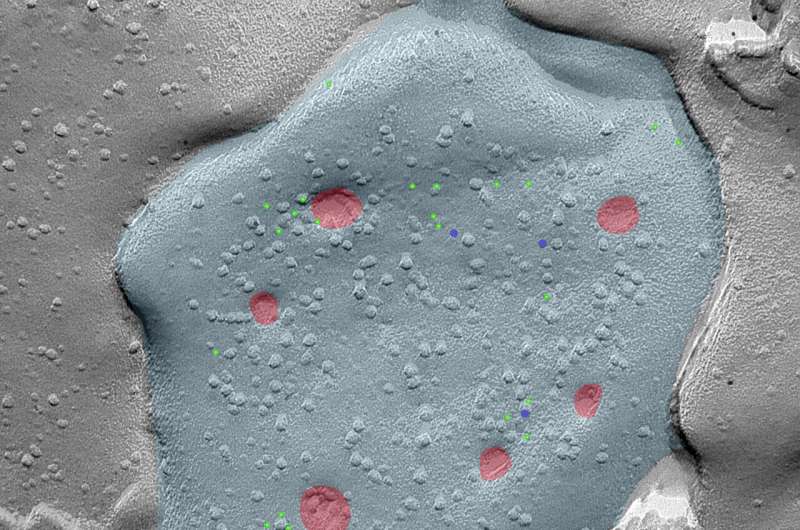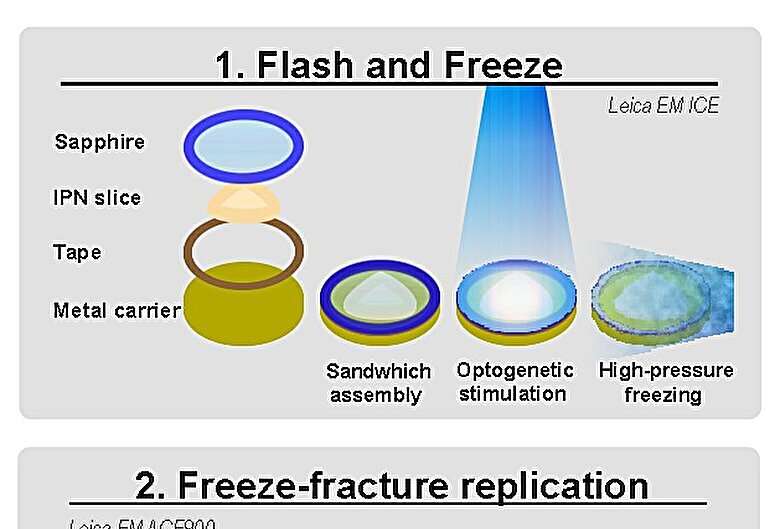This article has been reviewed according to Science X's editorial process and policies. Editors have highlighted the following attributes while ensuring the content's credibility:
fact-checked
peer-reviewed publication
trusted source
proofread
'Flash and Freeze-fracture' technique allows for neuronal insights into medial habenula

Fear and addiction exert significant influence within society. Managing them is often challenging, as they are driven by intricate neuronal circuits in our brains. Understanding the underlying molecular mechanisms is crucial to intervene when these processes malfunction.
Pioneered by scientists at the Institute of Science and Technology Austria (ISTA), the novel "Flash and Freeze-fracture" technique provides a unique glimpse into the respective brain region. The results were recently published in the journal PNAS.
While looking for food, a bird encounters a fox. It gets away just in time, but the sight and the sound of the predator lingers. The negative experience will form a memory in its brain and will be associated with fear and stress from now on. Whenever it meets a fox again, the fear memory is revived. The bird's attention spikes, its heart rate goes up, and it changes its behavior to reduce the risk of predation. Such memory is mediated by a specific brain region called the medial habenula, one of the epicenters for emotional processing.
Peter Koppensteiner, together with Pradeep Bhandari, Cihan Önal and other members of Ryuichi Shigemoto's research group at the Institute of Science and Technology Austria (ISTA) investigated this particular part of the brain to understand how its neurons communicate with each other. The results give an unprecedented look into this subject, utilizing a novel visualization technique called "Flash and Freeze-fracture."
Counter-intuitive brain cells
Nerve cells in the medial habenula exhibit unusual behavior, contradicting the general understanding of how neurons transmit signals to each other.
"Typically, communication between neurons is shut down, as soon as a specific molecule on the surface of the cells, known as the 'GABAB'-receptor, is activated," explains Peter Koppensteiner, previously a postdoc in the Shigemoto group and now a staff scientist at one of ISTA's Scientific Service Units (SSUs).
In neurons of the medial habenula, the exact opposite happens. "With the activation of GABAB, communication is elevated, to the extent that it shows the strongest synaptic facilitation throughout the entire brain," he continues. The underlying mechanism, however, was still unknown.

New method to uncover the inside of neurons
Driven by curiosity, the ISTA scientists embarked on a journey to decipher this phenomenon. The goal was to thoroughly examine medial habenula neurons in mice after they had been activated with a light flash. "It's a very challenging task," says Ryuichi Shigemoto. "The processes inside neurons occur in milliseconds, and classical electron microscope methods lack the temporal resolution to capture them."
A method formulated within the past decade, significantly influenced by Peter Jonas' research group at ISTA called "Flash and Freeze," proved to be a great starting point. It is a powerful tool, where neurons are frozen after being stimulated with light, to analyze the structure of neurons. The scientists now elevated it to the next level.
Their new "Flash and Freeze-fracture" technique introduces the possibility of also depicting proteins and molecules. This advancement allows researchers to track their trajectories, i.e., where proteins are going after neuronal activation, and reveal why they occupy distinct positions.
The latter is of particular importance. "The communication at the synapse varies depending on the localization of specific proteins. Our new method reveals that rapid position changes of some proteins strengthen the synapses," explains Koppensteiner.
Two proteins with previously unknown functions in particular, SPO and CAPS2, localize near the synapse, where CAPS2 anchors vesicles—tiny bubbles carrying neurotransmitters—to this region. A crucial event that enables a strong release of their messenger signals to the next nerve cell, thus facilitating communication between nerve cells.
Understanding these details could potentially open new doors to actively strengthen synapses in neurodegenerative diseases, where they are not functioning properly anymore.
Shigemoto adds, "I'm beyond excited about this remarkable publication that elucidates the mechanism of this peculiar phenomenon in the brain."
More information: Peter Koppensteiner et al, GABA B receptors induce phasic release from medial habenula terminals through activity-dependent recruitment of release-ready vesicles, Proceedings of the National Academy of Sciences (2024). DOI: 10.1073/pnas.2301449121





















